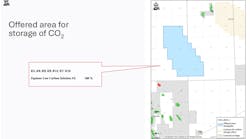The period of low oil prices has left its mark on Norway's oil sector, and stirred up a debate about fundamental policy issues such as the role of the state. The best publicized upheaval has been the takeover of Saga Petroleum by Norsk Hydro and Statoil, thus reducing the number of Norwegian oil companies from three to two.
Saga made itself vulnerable by its injudicious purchase of Santa Fe's UK assets in 1997, and was further undermined by low oil prices. In July, the European Union competition authorities gave the green light for the takeover to be consummated. Elf alone competed for the attractive assets which the government had put Saga's way over the years. The prospect of these passing into foreign hands dismayed political circles, but Elf's bid was supported by the employees as it offered fewer job losses.
At the end of the day, however, Statoil may get the best deal. In exchange for selling its Saga shares to Hydro, it gets a 25% share of the booty, which in the view of some is probably worth closer to 30%. Statoil will acquire interests in the producing Snorre, Troll, Norne, Gullfaks and Statfjord fields, in Halten Bank South's large undeveloped gas/condensate reserves, and Norne South's undeveloped oil reserves. Also included is the highly prospective deepwater Gjallar Ridge area, which was being drilled in July. Eventually, Statoil will take over operatorship of Saga's flagship asset, the Snorre Field, and of Hydro's Visund Field.
Commercial approach
About 800 jobs will be shed as Saga's organization is absorbed into Hydro's. Job losses currently are the order of the day in Norway, especially at the fabrication yards, as the flow of new orders has slowed to virtually nothing. Corporately, the suppliers' sector has remained intact so far, although Aker Maritime is up for sale. Kværner is also in the midst of a radical reshaping program after its financially indigestible acquisition of Britain's Trafalgar House, but has reaffirmed its commitment to oil and gas.
Meanwhile, there is talk of "slaughtering sacred cows," such as widespread state participation in the oil and gas sector. Survival in a low-price environment requires a fully commercial approach, and a strong state presence, while it might have been desirable in the sector's formative years, it is no longer helpful, or so the argument goes. Norway's policy looks increasingly out of step with the free-market policies espoused by the European Union (EU). One glaring example is the EU's gas directive, which clashes with the centrally controlled system of gas export authorization operated by Oslo.
While the political parties for the most part remain true to the philosophy of state interventionism, it is interesting to note that it is Statoil's own boss, Chief Executive Harald Norvik, who has been a leading light in calling for the partial privatization of the wholly-owned state company.
Norvik, who offered his resignation when the government sacked the company's board over cost overruns on the Åsgard project, and will soon be replaced, argues that Statoil needs greater freedom to act in its own right. It's commercial interests are not always best served by also having to manage the state's directly owned oil and gas interests, in his view.
On the other hand, he enthusiastically endorsed the Hydro/Statoil takeover of Saga.
It was a move in the direction of making a larger company with more financial clout, which Norvik sees as a precondition for its success in the global marketplace. But at the same time, it was a blow to notions of greater privatization. Saga was the nearest thing to a properly private Norwegian oil company, even though Statoil was its largest single shareholder, with almost 20%. Meanwhile, Hydro's largest single owner is the State, though its 51% stake has been diluted to around 44% as a result of the takeover.
High costs remain
Meanwhile, the debate about the high cost of operating in Norway goes on, with low oil prices adding more fuel to the fire. Early in the year, the government, concerned at the effect on employment as an increasing number of projects were shelved, promised to consider concessions. By the time they were announced, prices had begun to firm again.
The royalty charged on a number of older fields will be gradually reduced, and state participation in new licenses generally will be limited to 25%. But, there will be no removal of the carbon dioxide tax nor the additional 50% special tax levied on oil companies' operations, as the industry had hoped for.
For all the disappointment, however, the response to licensing opportunities has been enthusiastic. A dozen new licenses were awarded in May in areas of the North Sea close to infrastructure under the North Sea 1999 Awards. This was an impressively fast-track procedure, for which applications were invited only last November.
And in June, 16 companies submitted their nominations for Norwegian Sea acreage to be awarded under the 16th licensing round - 83 blocks or partial blocks were nominated by two or more of them. Awards are expected in the first half of 2000.
The accompanying table from the latest resource report from the Norwegian Petroleum Directorate indicates there is still a lot of oil and gas to be explored for in the country's waters.;
Statoil has brought its first smart well control system into use on the Gullfaks Field, and is already planning further installations, including the first on subsea wells in the Norwegian sector.
The company is using the SCRAMS (Surface Controlled Reservoir Analysis and Management System) supplied by PES. The first installation has been made on the C-29 well on Gullfaks C platform. Since operations began in April, the equipment has been working well, reports Oddbj rn Kopperstad, Chief Engineer in well and production technology. "However, it is too early yet to assess the benefits of the system," he says. "Value creation from such systems is time-dependent and very related to equipment reliability."
Statoil has evaluated such technology for several years and is looking for three main benefits from it, according to Kopperstad:
- A reduction in the number of well inter ventions, which are important in improving recovery, but time-consuming and costly
- An improvement in overall recovery
- Accelerated production through the ability to produce from more than one zone at a time.
Potential benefits of applying smart well technology are even greater for subsea wells than for wells on a drilling platform. The cost of intervention in a subsea well for which a mobile rig has to be mobilized is much higher - by a factor of 10, Kopperstad says. This is an important consideration for Statoil, which already has a large number of subsea completions, and expects that number to double over the next 3-5 years.
The company has performed simulations on some of the Gullfaks satellite wells which indicate that the use of SCRAMS could add NKr 400-500 million to a well's net present value. The company is due to take delivery of more SCRAMS systems this summer.
Locations have yet to be finalized, but are likely to include wells on the Gullfaks satellite fields, which will thereby become Norway's first subsea wells to be equipped with this technology. Coming deliveries will also include systems for installation in high-temperature wells, taking the technology a further step forward.
Statoil broadens smart well aims
Statoil is involved in a project with Norsk Hydro and Saga to develop documentation for the design, manufacture, and qualification of smart well systems, and Kopperstad stresses that, as with sophisticated downhole tools in general, reliability is a crucial issue. Downhole temperatures of 100°C or more push electronics to the edge, he says, while problems such as sand production, corrosion, erosion, and all kinds of deposition test equipment with moving parts to the limit.
To this end, Statoil has also taken initiatives such as involving Kongsberg Offshore on the control and communications side, as a result of which a substantially enhanced communications system for use with smart downhole equipment has now been developed.
Available systems for remote operated production control are at the high end of the range in terms of cost, Kopperstad says. Hence, Statoil plans to invest in the development and qualification of alternative lower-cost systems. One way of achieving this may be to include less features, but in some cases this might be acceptable and preferable.




